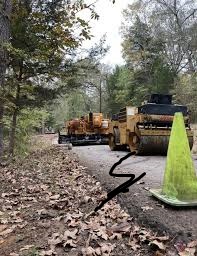It becomes even more important to resurface without replacement since the latter is expensive, time-consuming and anticipators the need for frequent repairing and maintenance.
There are two types of overlays: thin and thick overlays In thin overlay, a new layer of asphalt is placed over the existing pavement to to enhance the look of the surface as well as bring smoothness in the same layer.
Asphalt is suitable for surfaces that have deteriorated but are not yet weak or badly damaged to need complete overlaying.
Cracks sealing and fixing of potholes can help to prevent small problems affecting your paved areas.
Those cracks are prevented fro allowing water to get through to compromise the surface while potholes enable people and traffic to drive safely on the completed surface.
These services prevent the expenses associated with repair of pavements and any other future costs that may arise in future.
Steps in Asphalt Paving
In order to make parking space enduring for long durations there are processes that are followed by some experts including acquisition up to compaction .
All phases of the asphalt surface creation procedure substantiate its quality and durability.
This guideline comprises all the processes that produce the best outcomes in the execution of asphalt paving.
Site Preparation
First of all, the site where paving is to be done requires preparation before engaging in the activity.
A proper preparation of a site to receive an asphalt layer is received before the construction work commences to ensure the formation of a strong pavement surface.
Workers also demolish all waste material, stones and plants before beginning to pave the surface or floor intended to be paved.
The team required to clear the trees’ roots as well as the weed and any other material that compromise the stability of the pavement.
They then level the ground to ensure that it is relatively flat before actual construction begins The space is cleared, then leveled by the contractors who were hired for construction of a human settlement.
Preparations of ground slope to facilitate the work of construction crews for it to act as water drainage system.
Water will accumulate at the surface when working on the pavements without drainage planning and will later affect the asphalt.
An anticipated surface slope in paving that is properly established will make the water drain away from the road, thus preventing it from suffering future damage.
Both surface preparation and development of bottom soil in the project are entrusted to contractors.
Preparation before installing pavement

When necessary the contractor will deal with base of weak soils by adding drive for gravel or sand as a foundation for paving.
Before mixing, asphalt gets a reliable base during preparation to that its base will not alter in a way that a lasting result might be hampered.
The contractor needs to inspect the site to establish the areas where there is water accumulation or poor running before installing the pavement.
Drains are constructed for removal of water from areas of paved surfaces to prevent them from causing harm to the asphalt by resulting in weaknesses that compromise the strong foundations of the pavement.
Good drainage structures ensure that the asphalt remains intact even if there is heavy rain or extremely hot temperatures.